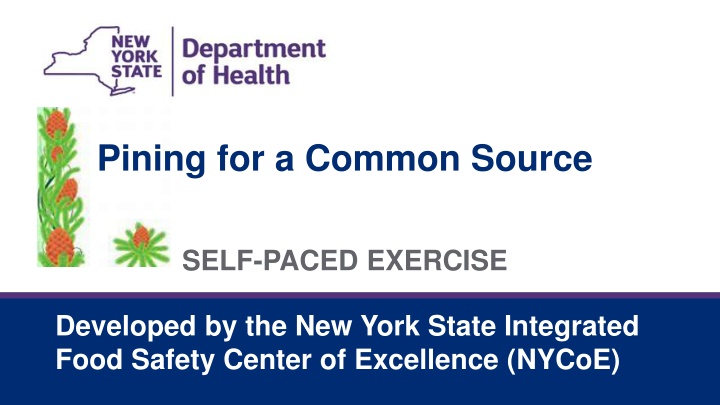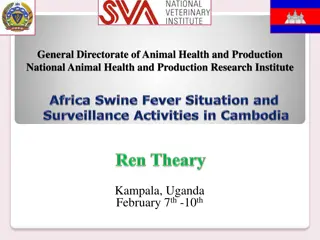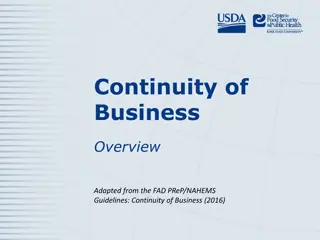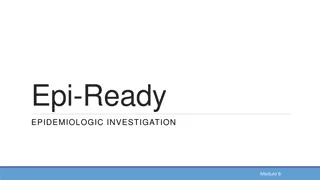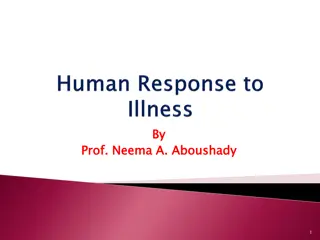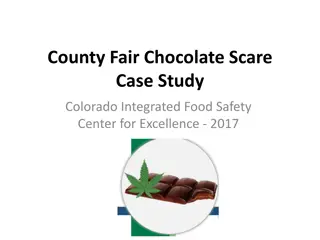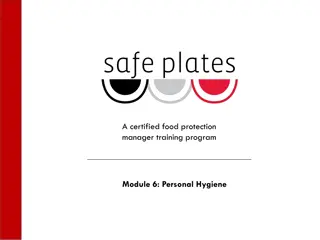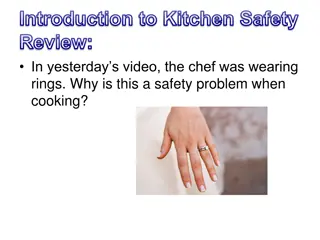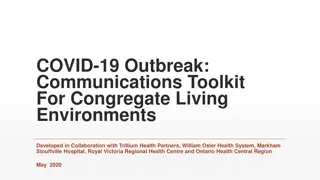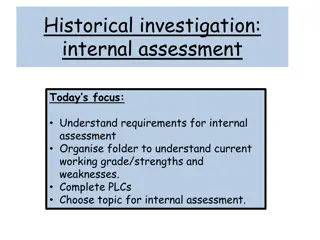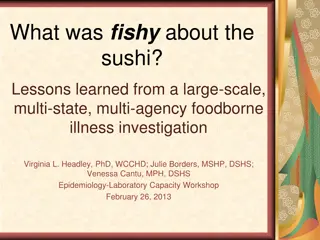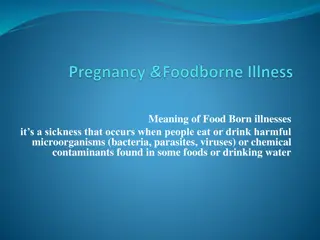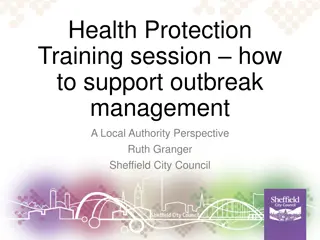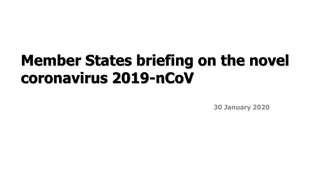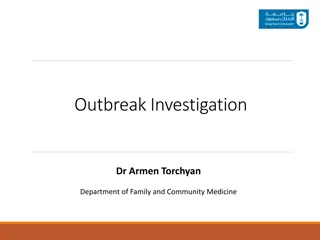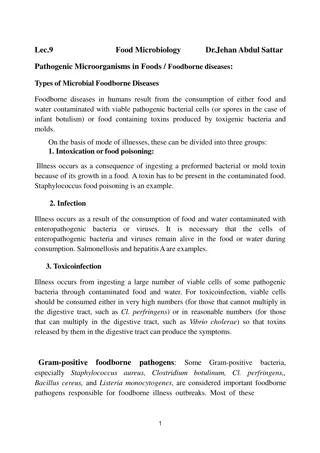Foodborne Illness Outbreak Investigation Procedures and Protocols
In this self-paced exercise developed by the New York State Integrated Food Safety Center of Excellence, learners will delve into the intricacies of investigating foodborne illness outbreaks. The course covers topics such as identifying outbreak patterns, roles in outbreak investigations, interpreting epidemic curves, refining case definitions, utilizing epidemiologic tools, conducting environmental assessments, and communicating investigation findings effectively. Real-life scenarios and practical skills are emphasized to equip participants with the necessary knowledge and skills for outbreak management.
Download Presentation

Please find below an Image/Link to download the presentation.
The content on the website is provided AS IS for your information and personal use only. It may not be sold, licensed, or shared on other websites without obtaining consent from the author.If you encounter any issues during the download, it is possible that the publisher has removed the file from their server.
You are allowed to download the files provided on this website for personal or commercial use, subject to the condition that they are used lawfully. All files are the property of their respective owners.
The content on the website is provided AS IS for your information and personal use only. It may not be sold, licensed, or shared on other websites without obtaining consent from the author.
E N D
Presentation Transcript
Image result for Pine Nut Clip Art Pining for a Common Source SELF-PACED EXERCISE Developed by the New York State Integrated Food Safety Center of Excellence (NYCoE)
2 Course Objectives: After completing this case study, you will be able to: Explain what constitutes a foodborne illness cluster/outbreak Describe the steps in a foodborne illness outbreak investigation Identify the roles and responsibilities of the outbreak investigation team Epidemiology, environmental health, laboratory and communications Understand the importance of information sharing during an outbreak investigation Draw and interpret an epidemic curve Establish and refine an outbreak case definition Describe the types of epidemiologic tools used during an outbreak investigation Describe the purpose of conducting environmental assessments/traceback investigations Describe the types of laboratory techniques used during an outbreak investigation Explain how to summarize and communicate outbreak investigation findings
3 PART A. THE INVESTIGATION BEGINS
4 Routine Disease Surveillance During the first week of September, five laboratory reports of SalmonellaEnteritidis are reported to Empire County in Liberty (LB) State from local laboratories In LB, physicians, hospitals and laboratories are required to report confirmed/suspected Salmonella infections to the local health jurisdiction where the patient resides This number of laboratory reports of S. Enteritidis is not unusual within the given time period and not considered above baseline for the county
5 Routine Case Follow-up Epidemiologists at Empire County investigate the Salmonella cases following standard procedures Each case is contacted to complete an initial interview using a standardized Salmonella questionnaire which collects information on exposures preceding their illness All clinical, laboratory, and exposure data are entered into a secure LB State Health Department (LBHD) electronic surveillance database
6 Routine Cluster Analysis Completed interview questionnaires are reviewed and compared by Empire County epidemiologists to identify: Commonalties (e.g., household contacts, attended same party or event) High-risk exposure settings (e.g., cases that work/reside in a sensitive setting such as a restaurant, daycare or healthcare facility)
7 Initial PFGE Report from the Laboratory On Friday, September 16, an epidemiologist from the LBHD Communicable Disease Program was notified that the LB State Public Health Laboratory (LBPHL) had 2 S. Enteritidis infections (from the 5 cases reported in early September) with matching pulsed-field gel electrophoresis (PFGE) patterns in Empire County The assigned XbaI pattern is JEGX01.0008
8 Note: In LB, hospital and commercial laboratories are required to submit all Salmonella isolates to the LBPHL where confirmation, serotype determination, PFGE and whole genome sequencing (WGS) are completed
9 Question 1: You are an epidemiologist at LBHD What additional laboratory information would you request from LBPHL?
10 Q.1 Answer The epidemiologist places an inquiry to LB State Lab to determine if PFGE pattern JEGX01.0008 is common or rare The epidemiologist will also request that a PulseNet search be performed to identify cases from other states that may have a matching PFGE pattern LB State Lab normally reviews PulseNet data for the prior 60 days, but this may vary by state or disease
11 Question 2: You are an epidemiologist at LBHD What steps would you take next?
12 Q.2 Answer The epidemiologist decides as a first step to review both patient case reports to identify dates of onset illness and any commonalities or rare exposures among the 2 cases The epidemiologist will also conduct a quick literature search to determine what products, if any, have been implicated in past outbreaks involving: S. Enteritidis, in general S. Enteritidis pattern JEGX01.0008, in particular
13 Question 3: What type of questionnaire do you use in your jurisdiction? What type of information is gathered?
14 Q.3 Answer Options may include: a lengthy, hypothesis generating questionnaire a short questionnaire to assess attendance at high-risk settings a short questionnaire that focuses on exposures commonly identified to be the source of Salmonella Type of questionnaire used will dictate what information is obtained and how it can be used in an investigation
15 Review of Initial Case Reports Case 1 is a 5-year-old male from Empire County Illness onset: 8/31 Symptoms: vomiting, diarrhea and fever Duration of illness: approximately 7 days Case 2 is a 16-year-old female from Empire County Illness onset: 9/9 Symptoms: nausea, vomiting, diarrhea and headache Duration of illness: approximately 5 days
16 Comparisons and Commonalities Cases were not household contacts Cases did not attend the same school Neither case attended large gatherings during their incubation period
17 Comparisons and Commonalities Both cases had exposure to: Commonly consumed items (chicken, tomatoes, eggs) Dining out (different locations) Supermarket Chain W (different store locations) Chain W is an extremely popular supermarket chain which has multiple locations in the region Household pets
18 Initial Investigation Laboratory Findings Late Friday afternoon, LBPHL verifies that there are no other matching isolates in other states at this time LBPHL also reports that PFGE pattern JEGX01.0008 had never been previously reported in LB State
19 Initial Investigation Communications The epidemiologist prepares a summary to send to the individuals on their investigation team to inform them of the cluster investigation and the action steps underway
20 Question 4: Who might be part of the investigation team? In one sentence, describe the role of each team member
21 Q.4 Answer Laboratory Investigator focuses on testing clinical specimens and environmental/food samples, and on analyzing/interpreting test results Environmental Health Investigator focuses on the contaminated food and/or food preparation site, water, and environmental sources Epidemiology Investigator focuses on cases, developing and testing hypotheses, and case finding to identify and describe clusters Public Health Nurse focuses on patient and public health education
22 The Basic Investigation Team At LBHD, epidemiologists and public health nurses often play overlapping roles Members of this team may also be comprised of staff from various levels of government (county/local health department, state health department, etc.)
23 Question 5: Would you involve all these team members right now? If not, who would you involve?
24 Q5. Answer The epidemiologist shares the cluster summary with the members on their investigation team from: LB State Health Department (LBHD) epidemiology and environmental health staff LB State Public Health Laboratory (LBPHL) Empire County (epidemiologists/public health nurses) Optionally: Empire County environmental health (if warranted, based on strength of food/event association)
25 Question 6: What are your next steps?
26 Q.6 Answer Right now, no commonalities, no other PFGE matching isolates so, with a sigh of relief, the epidemiologist leaves their office at 5PM - very pleased to not have to stay late and spend the entire weekend following up on this investigation Probably nothing to worry about !
27 PART B. ADDITIONAL CASES REPORTED
28 The Cluster Grows On Monday September 26th, LBHD is notified that LBPHL just confirmed 7 additional cases with PFGE-matching S. Enteritidis pattern JEGX01.0008 6 of the 7 new cases reside in Empire County The 7th case resides in Apple County (in LB State)
29 Case Review The epidemiologist compares the interview forms for all 9 LB cases to date 2 case interviews are pending 6/7 cases reported shopping at various locations of Chain W in Empire and Apple Counties, where the chain is a popular place to shop
30 Case Review None are members of the same household None work or reside in a sensitive setting No common restaurants or event exposures Food history exposures are extensively reviewed to identify the food items consumed by 50% or more of the cases Chicken, tomatoes, eggs and grapes
31 Case Review Note: Typically any exposure reported by 50% or more of the cases could be considered a possible hypothesis to explore further
32 Question 7: Describe how this situation could be defined as a cluster AND an outbreak? Provide an explanation for your choice
33 Q.7 Answer At this point, the investigation would be defined as a cluster To classify cases as part of an outbreak, there must be a common exposure among the cases, like dining at the same restaurant, attending the same catered event, or eating the same food item What about shopping at Chain W as a commonality?
34 Q.7 Answer While we have identified multiple PFGE-matching cases, at this point we have not been able to identify a link among the cases other than shopping at Chain W Some may consider this enough of a commonality to be an outbreak, however, the investigators in this cluster did not Chain W was the most popular grocery store chain in the area where the cases were occurring
35 Question 8: Who would you notify about this growing investigation?
36 Q.8 Answer The epidemiologist notifies members of their investigation team, which includes: LBHD epidemiology, environmental health and leadership staff (Department Directors) LBPHL Epidemiologists/public health nurses and environmental health investigators at Empire County Health Department and Apple County Health Department
37 Q.8 Answer The epidemiologist decides it is too early in the investigation to communicate with: The public (via a press release or public notification) USDA or the FDA as a contaminated product has not been suspected or confirmed The epidemiologist may or may not choose to notify CDC at this time Because no other PFGE-matching cases have been identified outside of LB State, the epidemiologist decides not to notify the CDC to alert them about this ongoing investigation
38 Cluster vs. Outbreak? The epidemiologist shares the new case count and exposure summary with the investigation team, and classifies the cases as a cluster, not an outbreak Although multiple PFGE-matching cases have been identified, no common associations among cases have been identified from review and comparisons of initial case questionnaires
39 Epidemic Curve The epidemiologist draws an epidemic curve of the cluster hoping to shed some light about how the Salmonella has spread and to provide a visual representation of the cluster The shape of the epidemic curve can reveal the outbreak s likely mode of spread
40 Point Source Outbreak All or the majority of cases occur within one incubation period The short duration of the outbreak suggests a single point of exposure event Cases rise rapidly to a peak and fall off gradually Examples include a GI outbreak following a wedding reception https://www.med.uottawa.ca/sim/data/Pub_Infectious_e.htm#epi_curves
41 Continuing Common Source Outbreak Cases occur over a prolonged period of time, spanning multiple incubation periods Cases are exposed to the same source but exposure is ongoing over a period of weeks (or more) The curve tends to rise gradually and may plateau Examples include consumption of a contaminated, commercially distributed shelf-stable food like dried cilantro https://www.med.uottawa.ca/sim/data/Pub_Infectious_e.htm#epi_curves
42 Propagated/Progressive Source Outbreak Person-to-person transmission, whereby a single infected case (index case) infects a group of others (initial wave), who then go on to infect others (secondary wave), etc. The curve presents as a series of progressively taller peaks, with peaks typically occurring one incubation period apart https://www.med.uottawa.ca/sim/data/Pub_Infectious_e.htm#epi_curves
43 Epidemic Curve The epidemiologist creates a line list of illness onset dates for S. Enteritidis cases, pattern JEGX01.0008 Case Onset Date 1 8/24/2017 2 9/1/2017 3 8/30/2017 4 9/5/2017 5 9/5/2017 Question 9: Use this data to draw an epidemic curve 6 8/28/2017 7 9/1/2017 8 9/5/2017 9 9/3/2017
44 Hints for Creating Epidemic Curves The epidemic curve is a histogram showing the number of outbreak associated cases by their time of onset Include a brief, descriptive title (including place and time) The x/y axis should be clearly labeled: The x-axis represents the date or time of illness onset among cases; the unit of time is usually 1/4 to 1/3 of median incubation period The typical incubation period for Salmonella is 2-3 days The y-axis shows the number of ill cases
45 Q.9 Answer: Epidemic Curve Illness Onset for S. Enteritidis Cases, Pattern JEGX01.0008 during August - September 2017 Question 10: What does the epidemic curve tell us about the likely mode of transmission? Number of Cases Illness Onset Date
46 Q.10 Answer The epidemic curve is most consistent with a continuous common source outbreak Cases do not all occur within one incubation period, thus decreasing the likelihood of a point source outbreak The epidemic curve suggests that our cases were exposed to the same source but exposure was prolonged over a period of days, weeks, or longer Cases will continue to be identified until the source of the outbreak is removed from commerce or people s homes
47 Case Review The epidemiologist examines demographic characteristics (e.g., gender, age, and race/ethnicity) of cases for possible clues as to what exposure is causing the illnesses Strong demographic characteristics of a cluster may suggest a particular food vehicle In accordance with religious practices, cultural traditions or preferences by age and/or gender
48 Empire County Facts Population: 220,000 Racial makeup 92% White 4% Asian 3% Black or African American 1% other races 2% of the population is Hispanic or Latino of any race 23% of the population is under 18 years of age Median age: 41 years
49 Demographic Characteristics of the Initial 9 Cases in the Cluster Question 11: Summarize the demographic information in the table Are there any noteworthy characteristics? Case County Age (yrs) Gender Race/Ethnicity 1 Empire 5 M White, Not Hispanic or Latino 2 Empire 16 F White, Not Hispanic or Latino 3 Apple 58 F White, Not Hispanic or Latino 4 Empire 24 F White, Not Hispanic or Latino 5 Empire 94 F White, Not Hispanic or Latino 6 Empire 49 M White, Not Hispanic or Latino 7 Empire 29 F Asian, Not Hispanic or Latino 8 Empire 54 M White, Not Hispanic or Latino 9 Empire 20 M White, Not Hispanic or Latino
50 Q.11 Answer The epidemiologist doesn t identify any noteworthy items 89% (8/9) white 100% non-Hispanic or Latino 56% (5/9) female Ages range is 5 94 years (median 29 years) 78% (7/9) cases are adults The epidemiologist wonders if the Apple County case travelled to Empire County during their incubation period Empire and Apple Counties are neighboring counties
